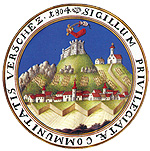 Visit Visit
VRŠAC, THE CITY OF CULTURE AND WINE, ON THE ROOF OF VOJVODINA
The Jewel of Southern Banat
If it gave birth to a comediographer such as Jovan Sterija Popović, painter like Paja Jovanović, poet like Vasko Popa, if it has famous vineyards and wines, if for centuries it has been maturing under the old Tower on the Hill, Đurđe’s, despot’s, if the highest peak in Vojvodina (Gudurički) is near it, from which one can see ”until the end of time” – then it is not an ordinary city and this is not a routine story about it, one of many. There, an hour of slow drive from Belgrade and Timisoara, two hours from Novi Sad, a lot is waiting for you. Whether you are a businessman, tourist, adventurer, traveler, explorer. You can also come by train, and you can fly. And we learned about this city and municipality from the president Čedomir Živković, a gentleman and entrepreneur
By: Goran Budimir
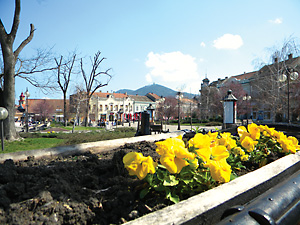 One afternoon this spring, it was a Friday, we sit in a young sun, in a coffee shop on the beautiful and spacious central square, amazed by the absence of neurosis and crowd, amazed by the collectedness and calmness of this city. We go through a chapter about it in the book Serbia – By Roads, Rails, Rivers, this true small encyclopedia of this country presented through an idea of a journey. (Wherever we find ourselves, we always dig out a lot if interesting things about this place, then we open our eyes wide and get absorbed in thoughts.) One afternoon this spring, it was a Friday, we sit in a young sun, in a coffee shop on the beautiful and spacious central square, amazed by the absence of neurosis and crowd, amazed by the collectedness and calmness of this city. We go through a chapter about it in the book Serbia – By Roads, Rails, Rivers, this true small encyclopedia of this country presented through an idea of a journey. (Wherever we find ourselves, we always dig out a lot if interesting things about this place, then we open our eyes wide and get absorbed in thoughts.)
”The Peak. Vršac (small peak).
The highest peak in Vojvodina, the northern province of Serbia.
Below it a city. Underpeaked.
It is mentioned under that name for the first time in 1427, in a letter written by Hungarian king Sigismund of Luxemburg, the founder of the Knightly Ord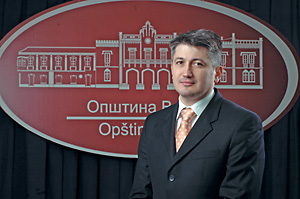 er of the Dragon. And the city also used to be called Varšoc, Veršec, Virška. In 1694 it was Veršoc, in 1707 Varšac... All these versions of its name contain Serbian (Slavic) word for peak.” er of the Dragon. And the city also used to be called Varšoc, Veršec, Virška. In 1694 it was Veršoc, in 1707 Varšac... All these versions of its name contain Serbian (Slavic) word for peak.”
This lofty city below the Vršac Mountains, the final southern solpes of the Carpathians – the book says – is one of four greatest centers of the Serbian part of Banat. It is located 83 kilometers from Belgrade, on the road from the capital to Timisoara, and only about ten minute drive from Vatin border cross. Belgrade-Bucharest railway runs through it. You can also fly to this city: the airport runway is 1,000 meters long and 25 meters wide. Today it has a population of about 37 thousand, and its economy is among the first ten in Serbia.
TWO DIRECTIONS OF DEVELOPMENT
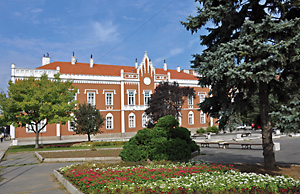 We are looking at that Tower, on the hill, Đurđe’s, despot’s. They say that the wisdom of the builders of Smederevo was embedded into it, people who were aware of the extent of danger coming from the ”Turkish sides”. A girl brings coffee, lively, laughing in four languages, whatever you ask her – she knows. Even the mayor. ”Well, he does not live on Mars, behind a bulwark of fortified secretaries, but here with us, in his city. He also comes here for coffee.” We are looking at that Tower, on the hill, Đurđe’s, despot’s. They say that the wisdom of the builders of Smederevo was embedded into it, people who were aware of the extent of danger coming from the ”Turkish sides”. A girl brings coffee, lively, laughing in four languages, whatever you ask her – she knows. Even the mayor. ”Well, he does not live on Mars, behind a bulwark of fortified secretaries, but here with us, in his city. He also comes here for coffee.”
The head of the city and municipality, Čedomir Živković, sophisticated and measured, with the tone of those people who do not know only what they want, but also how they want it, he welcomes us as agreed, at the exact time.
– Vršac is developing in two major directions. One is service sector, and the other is commercial-economic – he says. – In some countries, Slovenia for example, between 30 and 40 percent of income comes from service sector (primarily different types of tourism), 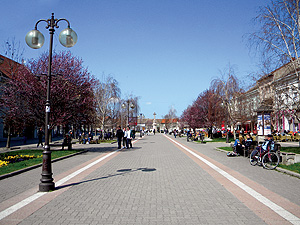 whereas in our northern province it amounts to less than 3 percent. It is indisputable that the potentials of Vršac, and this area in general, are great. And that there are clear ways to exploit them to a much higher extent than now. Directing more attention to service sector, culture and tourism as resource, is one of those ways. Numerous attractive cultural events, for which our city is famous, should also contribute to this Tome. ”Days of Harvest and Grape”, those picturesque wine celebrations on the passage from summer to fall, have a tradition more than half a century long and a large number of regular visitors. There are also ”Vršac Theatre Fall”, International Folklore Festival ”Vršac Wreath”, traditional cultural events related to lives and work of Vršac people who are the great names of Serbian culture (Jovan Sterija Popović, Paja Jovanović, Vasko Popa...). These are only a few of them, but this is an entire calendar of live cultural events, the significance and attractiveness of which far exceed the borders of our city. whereas in our northern province it amounts to less than 3 percent. It is indisputable that the potentials of Vršac, and this area in general, are great. And that there are clear ways to exploit them to a much higher extent than now. Directing more attention to service sector, culture and tourism as resource, is one of those ways. Numerous attractive cultural events, for which our city is famous, should also contribute to this Tome. ”Days of Harvest and Grape”, those picturesque wine celebrations on the passage from summer to fall, have a tradition more than half a century long and a large number of regular visitors. There are also ”Vršac Theatre Fall”, International Folklore Festival ”Vršac Wreath”, traditional cultural events related to lives and work of Vršac people who are the great names of Serbian culture (Jovan Sterija Popović, Paja Jovanović, Vasko Popa...). These are only a few of them, but this is an entire calendar of live cultural events, the significance and attractiveness of which far exceed the borders of our city.
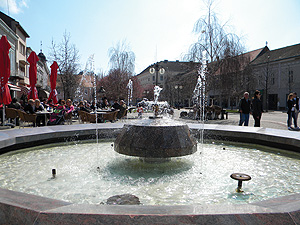 Book: ”Today it is a modern city, with a developed network of schools, sports clubs, cultural institutions, healthcare institutions... The city of ‘Hemofarm’, ‘Vršac Vineyards, ‘Vršac Brewery’, ‘Banat’, ‘Banatian Riesling’, excellent chocolate, cookies, ‘zoffman’, ‘multivita’...” Book: ”Today it is a modern city, with a developed network of schools, sports clubs, cultural institutions, healthcare institutions... The city of ‘Hemofarm’, ‘Vršac Vineyards, ‘Vršac Brewery’, ‘Banat’, ‘Banatian Riesling’, excellent chocolate, cookies, ‘zoffman’, ‘multivita’...”
– Especially important for the spirit and identity of our city are numerous traces of its long history and culture, but also its modernity – says mayor Živković. – Definitely worth attention are Vršac Tower, Baroque Palace Vladičanski dvor (the seat of Banat Eparchy), Nikolai’s Church, neo-gothic Cathedral of Saint Gerhard, Magistrate, the house of Jovan Sterija Popović, the City Museum (holding a rich archaeological collection from the sites Vatin, Dubovac, Židovar), National Theatre ”Jovan Sterija Popović”, gallery ”Pharmacy on the Stairs”, Vršac city center as an architectural and urbanistic unit, ”Milenijum” Centre, airport of the Flight Academy... Only nine kilometers from the city there is also the famous Mesić Monastery from the 13th century...
LIVE CULTURE, VIEWPOINTS, WINES
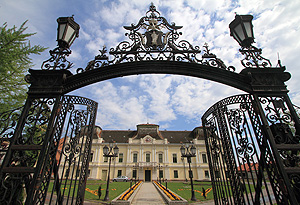 That is both treasure and strength, says the mayor. But cultural monuments live and radiate, produce effects only if they are surrounded by people, if they are a place of gathering and new creations. If they languish, if they are forgotten, chained in negligence, then they turn into monuments of poor state of spirit and mind of our contemporaries, monuments to irresponsibility and despair. That is both treasure and strength, says the mayor. But cultural monuments live and radiate, produce effects only if they are surrounded by people, if they are a place of gathering and new creations. If they languish, if they are forgotten, chained in negligence, then they turn into monuments of poor state of spirit and mind of our contemporaries, monuments to irresponsibility and despair.
– Because of all this, last year we started a comprehensive reconstruction of the Vršac Tower, symbol of the city from the 15th century, which was in a very poor condition. The Municipality of Vršac, in a partnership with the Provincial Secretariat for Culture and ”Hemofarm” Foundation, entered into this project to restore the initial beauty of that place. Our idea is to bring life to the Tower, namely the Vršac Palace (as it will be called after the reconstruction), to enrich it with a museum exhibition (which will include exhibits found on that site), galleries, art studios, pretty hospitality establishments... We have already completed the first phase by restorin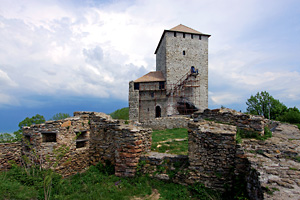 g the donjon tower: it was given a narthex and a roof made of shingle, just like the one it had six centuries ago. This year we will continue with the construction of the small tower. After the completion of reconstruction, the entire edifice will get back its former medieval appearance, it will have one vitrified area, and will become much more interesting for visitors. g the donjon tower: it was given a narthex and a roof made of shingle, just like the one it had six centuries ago. This year we will continue with the construction of the small tower. After the completion of reconstruction, the entire edifice will get back its former medieval appearance, it will have one vitrified area, and will become much more interesting for visitors.
Additionally, thanks to the cross-border project with partners from Romania, we are going to begin the reconstruction of Konkordija, the old museum building in Vršac. It had different purposes throughout its history, and is now being unused. Its former museum purpose will be restored.
An important competitive advantage in Vršac offer are certainly the Vršac Hill, the lake, vineyards, running tracks...
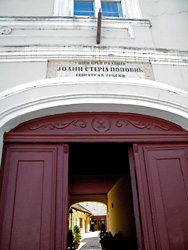 – many do not know that the highest peak in Vojvodina is not on Fruška gora, but right here in Vršac Municipality. It is the Gudurički Peak, 641 meters high, and you can see far away from there. All those plains. Recently, we have refurbished a viewpoint on the hill, and our guests can easily find this for themselves – says the mayor Čedomir Živković. – Vršac Hill, in itself, has always been an interesting destination for mountaineers, cyclists, athletes, nature lovers in general, but also for those who love paragliding. Thanks to the ideal conditions on the hill from where they take off, good wind and the plains that opens up below them, and where they can safely land, there are more and more paragliders on the sky above Vršac. – many do not know that the highest peak in Vojvodina is not on Fruška gora, but right here in Vršac Municipality. It is the Gudurički Peak, 641 meters high, and you can see far away from there. All those plains. Recently, we have refurbished a viewpoint on the hill, and our guests can easily find this for themselves – says the mayor Čedomir Živković. – Vršac Hill, in itself, has always been an interesting destination for mountaineers, cyclists, athletes, nature lovers in general, but also for those who love paragliding. Thanks to the ideal conditions on the hill from where they take off, good wind and the plains that opens up below them, and where they can safely land, there are more and more paragliders on the sky above Vršac.
Of course, the story about Vršac cannot be told, and this city cannot be understood, if we do not say a word about its wine. Many come here primarily because of it, and then they learn everything else and become attached. The mayor describes the Vršac ”wine road”, conceived in such a manner that a guest can visit the famous Vršac vineyards, wine villages Gudurica and Veliko Središte, far famed local wine cellars... It is nice to listen, and even nicer to walk that road, with a smile and curiosity.
IN THE NEIGHBORHOOD OF THE EU
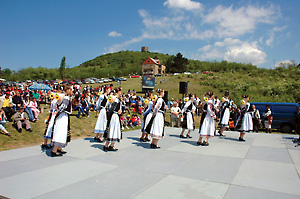 – We should definitely not leave out our villages – says the mayor Živković. – Vršac Municipality has 22 villages. The objective, on the realization of which we are currently working, is to raise the standards of living in villages and bring them quite close or equal to those in the city. That is why we are trying to systematically build infrastructure, but also to invest into cultural and spiritual life there. Our villages are picturesque, they have different ethnic legacies (in addition to Serbian, we have predominantly Romanian villages, one is predominantly Hungarian, some have population of mixed ethnic origin), good cellars and a long wine culture. They also have rare buildings, such as the wind-well in Šušara (work of Eiffel Bureau), palaces in Vlajkovac and Veliko Središte... – We should definitely not leave out our villages – says the mayor Živković. – Vršac Municipality has 22 villages. The objective, on the realization of which we are currently working, is to raise the standards of living in villages and bring them quite close or equal to those in the city. That is why we are trying to systematically build infrastructure, but also to invest into cultural and spiritual life there. Our villages are picturesque, they have different ethnic legacies (in addition to Serbian, we have predominantly Romanian villages, one is predominantly Hungarian, some have population of mixed ethnic origin), good cellars and a long wine culture. They also have rare buildings, such as the wind-well in Šušara (work of Eiffel Bureau), palaces in Vlajkovac and Veliko Središte...
Geographical position of Vršac, somehow ”pocketed”, ”on the margin”, has been for decades regarded as an aggravating factor in economic, primarily industrial and traffic-communication development. However, the new millennium brought some significant changes in this respect.
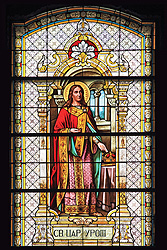 – After Romania has become a member state of the European Union, this position became our advantage. We are no longer ”forced along the iron curtain”, but are neighbors of the European Union, on its southeastern doors – explains Živković. – With a complete infrastructure, excellent roads, only 14 kilometers from Romanian (EU) border, we are a very interesting destination for hundreds of Italian and other companies that have been opened in the vicinity of Timisoara in the past years. We are currently building a roundabout road around Vršac, which will be a part of Corridor XI (highway Belgrade-Vršac-Timisoara), lift a significant burden from the city center in terms of traffic and provide conditions for development of another industrial zone. An important developmental potential of our entire region is the Vršac Technological Park, the highest investment of the EU in Serbia in 2009. Along the major road Belgrade-Vršac-Vatin, occupying 27hectares of land with full infrastructure, this Technological Park offers great conditions for investors. – After Romania has become a member state of the European Union, this position became our advantage. We are no longer ”forced along the iron curtain”, but are neighbors of the European Union, on its southeastern doors – explains Živković. – With a complete infrastructure, excellent roads, only 14 kilometers from Romanian (EU) border, we are a very interesting destination for hundreds of Italian and other companies that have been opened in the vicinity of Timisoara in the past years. We are currently building a roundabout road around Vršac, which will be a part of Corridor XI (highway Belgrade-Vršac-Timisoara), lift a significant burden from the city center in terms of traffic and provide conditions for development of another industrial zone. An important developmental potential of our entire region is the Vršac Technological Park, the highest investment of the EU in Serbia in 2009. Along the major road Belgrade-Vršac-Vatin, occupying 27hectares of land with full infrastructure, this Technological Park offers great conditions for investors.
***
 Paja Paja
To the honor of Vršac born Paja Jovanović, one of the most significant Serbian painters of all times, since 1959 (on one hundredth anniversary of his birth) an art event has been organized here, which provides an award that carries his name. The exhibition of the best works from the event always opens on June 4th, on the birthday of Paja Jovanović, and at least some of 180 painters from Vršac always participate.
***
Literary Municipality
It has been almost four decades that the famous Literary Municipality of Vršac has been active here. One of its founders is Vršac born Vasko Popa, a renown Serbian poet, and was managed for a long time, prudently and enthusiastically, by Petru Krdu, a great local poet and journalist. Only until a few days ago, when he suddenly died at the age of 59.
The Literary Municipality awards the European Poetry Award, and the winners also become its members. And so, the list of its members includes writers of such a rank like Sanguineti, Mark Strend, Milorad Pavić, H. M. Encesberger, Miodrag Pavlović, Charles Simić, Michel Deguy, Stefan Augustin Donaš, Tadeus Ruzevic, Allen Ginsberg, Paul Muldoon...
***
Theatre
The first theatrical performance in Serbian language was organized in Vršac as far back as in 1793, an account says. It was performed by the students of local Grammar School. There had been theatrical performances in this city even before, but those were tours of German theatres from Timisoara.
***
A Weekend in Vršac
– With a five star Hotel ”Vila Breg”, Hotel ”Srbija”, ”Milenijum” Hall (with 5,000 seats), Vršac Mountains and all described programs offered by Vršac, I think that we are an excellent weekend destination for guests from Belgrade and Timisoara, who are only an hour of slow drive away, as well as for guests from Novi Sad, which is only two hours away – concludes mayor Živković.
***
Airport
Vršac has long been connected with air sports, and the local airport is today a special potential for the development of the city. The Flight Control Agency (SMATSA) took over the Vršac airport from JAT and established the Aviation Academy. It is planned that capacities of the airport will be expanded, the runway will be elongated, the fleet restored, and the training centre for pilots and flight controllers is planned to be relocated from Belgrade to Vršac. If this airport were to become international, and airplanes from about ten destinations could land in Vršac, it would have an exceptional value for the development of tourism in the entire region.
|
